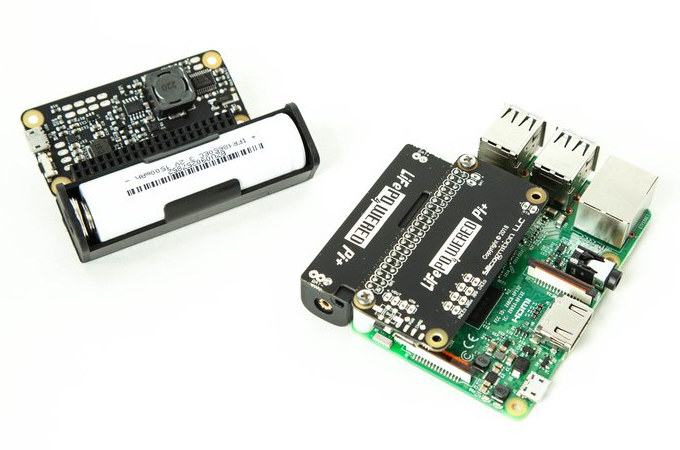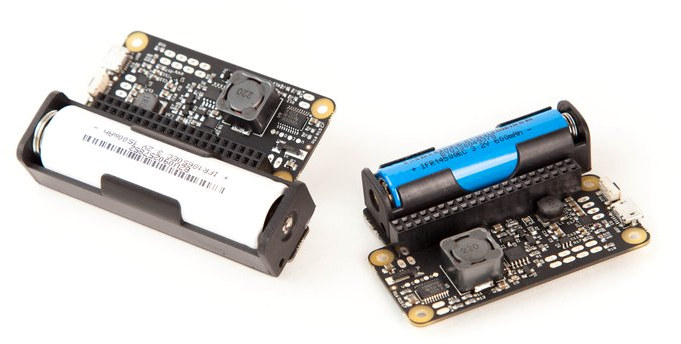We’ve already covered several UPS solution for Raspberry Pi boards, but LiFePO4wered/Pi+ is a little different because instead of relying on LiPo (Lithium Ion Polymer) batteries, it comes with LiFePO4 (Lithium Iron Phosphate) battery which are said to be safer and longer-lasting albeit at the cost of lower capacity.
 LiFePO4wered/Pi+ specifications:
LiFePO4wered/Pi+ specifications:
- Two battery size options:
- 18650 size – 1,500 mAh 3.2 V LiFePO4 cell with up to 2A max continuous load current
- 14500 size – 600 mAh, 3.2 V LiFePO4 cell with up to 0.75 A max continuous load current
- Smart charge controller – Over-charge protection, auto-adjusting charge current, customizable maximum power point (MPP) voltage
- Smart power manager:
- I2C communication
- Power manager and daemon – work together to ensure clean shutdowns and provide over-discharge protection
- Continuous monitoring – input voltage, battery voltage, output voltage, and load current
- On/off button
- Green PWR LED & Red CHRG LED
- Wake timer – Wakes up RPi as needed for low duty cycle applications.
- Real-time clock
- Auto boot
- Auto shutdown when input power is removed, either immediately or after a programmable amount of time.
- Application watchdog – Flash the PWR LED or trigger a shutdown/reboot if the user application fails to service the timer within a configurable amount of time.
- Dimensions
- 18650 size – 52 mm x 75 mm
- 14500 size – 47 mm x 65 mm
Beside the Raspberry Pi boards, the board has been tested with Odroid-C2, NanoPi S2, some Allwinner H3 boards, and ASUS Tinker Board. It should work with any board compatible with the 40-pin RPi header.

LiFePO4wered/Pi+ board can power a Raspberry Pi for up to nine hours from its battery. Silicognition LLC – the company behind the project – provide several open source host-side tools and software package namely LiFePO4wered daemon that takes care of shutdown and RTC management, lifepo4wered-cli command line tool for configuration and access to all features, as well as shared libraries with language bindings for C/C++, Python and Node.js, all of which can be found in their GitHub repo.
Some of the advantage of Lithium Iron Phosphate (LiFePO4) batteries over LiPo batteries include:
- High continuous load current
- Longer lasting with thousands of recharge cycles, instead of just hundreds
- Safer, as they don’t catch fire or explode
- More Stable: 3.2 – 3.3 V during most of discharge
- More durable with low self-discharge rate, no memory effects, no degradation from extended charging
- Environmentally friendly with no heavy metals, RoHS compliant, and reusable thousands of times
- Better suited to rough environments, as they can operate in both cold (down to -20°C) and hot (up to 60°C) temperatures.
The UPS / battery management board is now offered on CrowdSupply where you can pledge $39 for the 14500 kit with a 600 mAh battery, or $45 for the 18600 kit with a 1,500 mAh battery. Shipping is free to the US, but adds $10 to the rest of the world. Delivery is scheduled for the end of October 2018 (14500 battery kit) or January 2019 (18600 battery kit).

Jean-Luc started CNX Software in 2010 as a part-time endeavor, before quitting his job as a software engineering manager, and starting to write daily news, and reviews full time later in 2011.
Support CNX Software! Donate via cryptocurrencies, become a Patron on Patreon, or purchase goods on Amazon or Aliexpress




